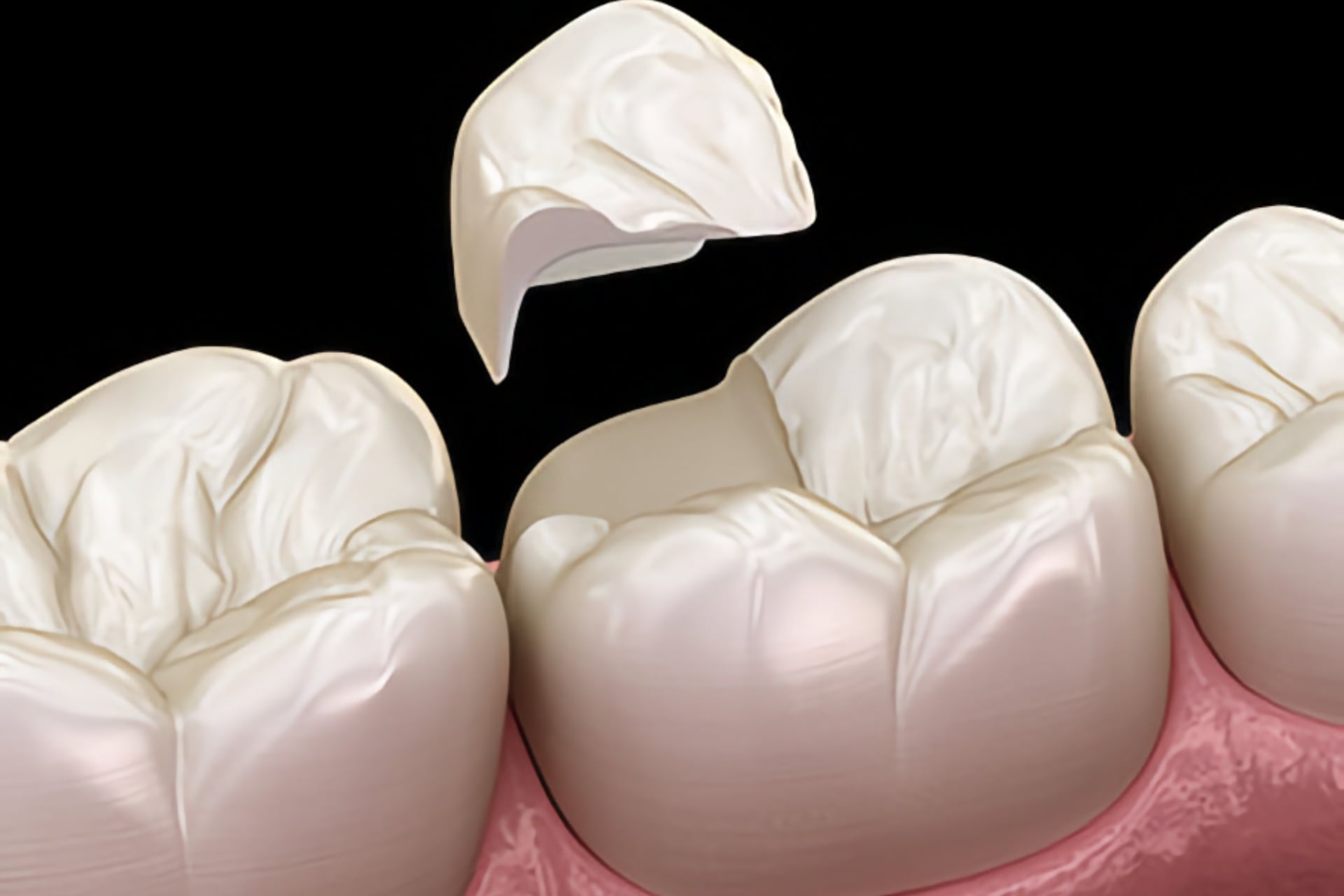What is a veneer?
Veneers are almost transparent, metal-free ceramic shells that are glued to the visible surface of the teeth, giving a perfect, flawless appearance. This natural-looking cover is always individually made in a dental laboratory.
Veneers are often used for accident-damaged, chipped and discolored front teeth. Only an area between 0.3 and 0.7 mm in size will be ground away from the tooth enamel and the tooth cutting edge will only be about 1 mm shorter. This is the space needed for the veneers.
Veneer combines two important positive aspects: on the one hand, only a small part of the natural tooth structure is ground down, causing only minimal damage on the original tooth and on the other hand it results in an excellent, long-lasting aesthetic effect.

We recommend veneers in the following cases:
- Enamel defects, discoloration and tooth decay
- The cutting edges of the teeth are broken
- Color correction of root-treated teeth
- Reduction of gaps between teeth
In which cases are veneers not recommended?
- In case of inadequate oral hygiene
- For severely carious or severely damaged front teeth
- For certain bite disorders
- If one grinds their teeth at night or clench them very hard
The available long-term clinical studies show that after six years only 2 percent of the shells have fallen off. This positive result led to the German Society for Dentistry, Oral and Maxillofacial Medicine now recognizing and highly valuing this method.
Dental filling, Inlay, Onlay
When is it time for a tooth filling? What are the signs of a damaged tooth? Which filling materials can you choose from at the FlyDent clinic? In this section we answer your questions about aesthetic and conservative dentistry.
A dental filling becomes necessary if the tooth is damaged. The loss of tooth structure can occur due to tooth decay or an accident, but it is often acids that damage tooth enamel and cause toothache. Another reason can be severe teeth grinding or an injury to the neck of the tooth.
If you’re not sure whether you need a dental filling, here are some signs to watch out for:
- Sensitivity of the teeth to cold, hot and sweet foods
- One may feel a hole or damage in the tooth with the tongue
- The teeth react sensitively to chewing

Removal of amalgam fillings
One of the most important features of the now outdated amalgam filling is that it contains mercury. The general standpoint claims that harmful mercury can be released due to teeth grinding or even chewing. Amalgam fillings are now also prohibited for pregnant women and children.
A healthy lifestyle is closely linked to the principles of our clinic, which is why we always avoid the use of amalgam fillings.
However, we are happy to remove amalgam fillings while taking appropriate precautions.
What types of dental fillings are there?
In today’s aesthetic dentistry, less and less metal is used, plastic and porcelain and their alloys are gaining more and more space.
The composite filling has the great advantage that, after hardening under the influence of light, it creates a surface that is very similar to the texture of the original tooth. It can also be completely color matched to the real tooth allowing both a great aesthetic and functional result.
If tooth decay is not yet very extensive, aesthetic composite tooth fillings are used. If caries is already advanced, i.e. a larger surface of the tooth is affected, then conventional dental fillings can no longer restore the shape and chewing function of the original tooth.
In this case, we create inlay or onlay dental fillings, which can be made of gold, plastic or ceramic.
Inlay and onlay dental fillings
The inlay can be imagined as a bonded dental filling that is made individually for each person by a dental technician based on a dental imprint.
Inlay tooth fillings are mainly used when a molar is broken or the tooth decay is too extensive. If the entire chewing surface does not need to be covered, an inlay can be used.
If there is major damage including the surface of the tooth, we use onlays. An onlay is very similar to an inlay, it is just more extensive and includes the surface. The name indicates it lies not only in the tooth (inlay) but also on the tooth (onlay). If the hole is larger and the entire chewing surface needs to be covered, we use onlays, too. In these cases, not only the chewing surface but also the damage to the tips of the teeth must be treated. Just like an inlay, an onlay is made by the dental technician after the dental imprint has been taken and then inserted.

Toothache after filling
After a dental filling, pain can occur and last 3 to 7 days. Depending on the size and location of the carious areas, the nerve fibers and gums can be overloaded causing this effect.
The pain feels bright and sharp and may be constant at first. If the pain is more severe, it can be relieved with paracetamol or ibuprofen.
Painless root canal treatment
Root canal treatment involves the removal of the nerves in the tooth root – also called the pulp. Many people think of root canal treatment as terrible and think about it with great fear, even though the opposite should be the case.
With a root canal treatment we want to avoid the much more drastic solution of tooth extraction. In our clinic we always strive to ensure that our patients can keep their own teeth for as long as possible.
We attach great importance to allaying fears before the dental treatment and this also applies to root canal treatments. At Flydent Clinic, we prevent our patients from having to have their teeth extracted by providing completely painless root canal treatment.

